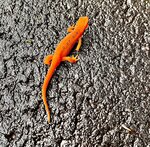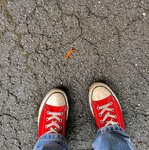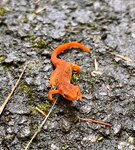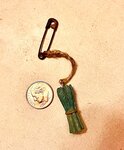As many of you know, there’s a new pooch in the house, because life without Dharma the Wonder Dog was unbearable. So here we are—just me and That Dog Named Gidget, who is now 17 weeks …
Stay informed about your community and support local independent journalism.
Subscribe to The River Reporter today. click here
This item is available in full to subscribers.
Please log in to continue |







As many of you know, there’s a new pooch in the house, because life without Dharma the Wonder Dog was unbearable. So here we are—just me and That Dog Named Gidget, who is now 17 weeks old.
That’s right—four months and change—and what a change it’s been.
Not only is she a rambunctious puppy who needs constant supervision, but I haven’t had to train a juvenile in a long, long time—much less walk one somewhere between five and 50 times a day.
I’ve had a dog at my side my entire life. Some were rescues, some were not, but this one is bound for future service-dog training and starting with a puppy seemed like the way to go.
You know what they say about hindsight being 20-20? Oy. Sure wish I were clairvoyant.
That said, she’s here, she’s growing like a weed and we’ve bonded big time, but it’s been a rough road, figuratively and literally. Since there’s “no rest for the wicked,” I’m leashing her up morning, noon and night, traversing the neighborhood at all hours, rain or shine. Every day we can be spotted on the roads near Camp Fox learning how to “heel,” “sit,” “stay” and “Come here!”
Oftentimes my neighbors can hear me screaming “What’s in your mouth?” and “Drop it!” as Gidget bounds through the tall grass, emerging triumphantly with a variety of things clenched in her jaws.
So far, she’s retrieved an old Styrofoam cup carelessly flung out a car window, bits of garbage left behind by raccoons and bears, and once it was (oy) a rubber band. I don’t know how or where she’s finding them, but I’ve had to shove my hand in her mouth and extricate wads of chewing gum no fewer than six times.
And then there are the critters she scoops up: crickets, a dead bird (don’t ask) and even a butterfly’s wings (just the wings). But lately, it’s salamanders—specifically my favorite: the impish red eft.
Although the babies are tiny and hard to spot, I actively look for them after a good rain, since they love moisture and often venture out of the woods and onto the country roads following a storm.
Frankly, the dog doesn’t care if they’re dead or alive, but I prefer neither—hence the “Drop it” command that she is learning. She reluctantly spits out her prize, which sometimes scurries away. Isn’t that great?
I’ve been drawn to red efts since childhood because they’re adorable (IMHO) but I never knew much about them. So I turned to the Google, which directed me to the New York State Department of Environmental Conservation (DEC).
Happily, I learned a bunch of cool stuff like this:
“The juvenile [eft] can be identified by its bright orange-red coloration with small black dots scattered on the back and a row of larger, black-bordered orange spots on each side. The larger spots resemble an eye, which is the meaning of their scientific name ‘Notophthalmus’.”
“Cool, right?” I mumbled to Gidget, who was gnawing on something unrecognizable.
I also learned that the adult (called a newt) has “an overall greenish coloration with small black dots scattered on the back and a row of several black-bordered reddish-orange spots on each side.”
She hasn’t thrown up one of those yet.
But is it a salamander? I typed my query into my smartphone while watching the dog chew on some kind of plant that left spiky burrs in her whiskers. “Drop it, girl,” I commanded with an exhausted sigh. Burrs. Yay.
“The Eastern red-spotted newt is a widespread, native salamander of New York State and eastern North America that can live for 12-15 years.”
Wow, man. That is, if your puppy doesn’t find it first.
More facts flickered across my phone’s screen.
“Larvae live in water and use gills to breathe. However, juveniles (1-3 inches) become land dwellers developing lungs to breathe air. The adults (3-5) also breathe air, but become aquatic once again.” Hmm.
“The red-spotted newt secretes poisonous toxins, and the eft’s bright coloration serves as a warning to predators.”
“Who knew?” I whispered to the dog, who cocked her head and casually spit out a dead bee.
I read and walked, keeping my third eye on you-know-who, who may or may not have had a red eft in her mouth.
“Eastern newts use specialized chemicals to find food and attract mates, and help reduce mosquito populations by feeding on their larvae.” Yet another reason to love the little guys.
I’ll be strolling a lot more as the pooch continues to grow, so may as well make use of the time and teach That Dog Named Gidget some manners, while learning new things about this wonderful world we live in. Looks like walkin’ the dog might be good for us both.
What’s she gonna do next?
Read all about my puppy’s adventures right here and follow her on Facebook and Instagram @ThatDogNamedGidget.
Fun fact: “Walkin’ the Dog” is a song written and performed by Rufus Thomas. Released in 1963, it was his signature hit and also his biggest, reaching number 10 and remaining on the Billboard Hot 100 for 14 weeks.
Ask the Google: Q—What does “No rest for the wicked” mean?
A—Originating as a biblical quote, “No rest for the wicked” is a proverb that means evil-doers will face eternal punishment, and has been popularly extended to mean that one’s work never ceases.
To learn more about all creatures great and small inhabiting the Catskills region, go to www.dec.ny.gov/animals/67022.html.
Comments
No comments on this item Please log in to comment by clicking here